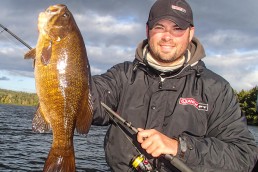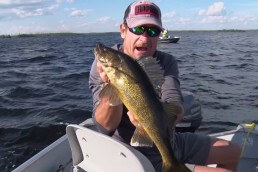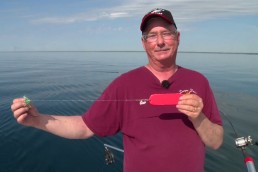Tackling Turnover to Catching Fall Footballs
SHARE THIS POST
Autumn smallmouth fishing strategies and locations must center on the stages and cycle of fall turnover
From September to early November, it’s football season in the north for smallmouth bass.
As the waters cool, smallmouths undertake their annual wintering migrations into deep water. Turnover and each of its phases is the focal point of fishing during the autumn season. If fishing strategies and locations aren’t being planned according to the phases of turnover, the pursuit of fall footballs becomes challenging.
The fall fishing season encompasses three sub-seasons that shape fish movement and location: early fall, mid fall and late fall. Each stage requires different strategies. With the entire turnover cycle taking place during autumn’s sub-seasons, it encompasses three phases too: pre-turnover, turnover and post-turnover.
Tackling turnover
Most anglers associate turnover to being short-lasting, at 55- to 57-degree surface temps. However, the cycle begins once summer peak establishes on lakes that stratify, long before the lakes turn over.
By midsummer, many of the lake’s adult smallmouths have already gradually moved into the deepest, structure-filled reaches of the lake where good oxygen levels and their optimal water temperatures are present.
Smallmouth and their forage species experience predator-prey relationships. Beyond turnover’s influence, fall smallmouth locations also correlate with their prey’s. During all phases of turnover, baitfish migrations are prevalent and can provide improved feeding windows.
Pre-turnover officially arrives in late summer, lasting through mid-September when cooling weather and water temperatures are the cycle’s main driving forces. Water temperatures that might have been pushing 80 degrees prior to Labor Day have now fallen into the mid 60s. Late summer and early fall cooldowns further influence smallmouth movements to deep water, but they frequently bring deep-dwelling fish back to the shallows where they will temporarily take up residence along flats, rock bars and deep weed edges of green cabbage and coontail to feed on yellow perch schools. The cooling water temperatures into the lower 70s and upper 60s become optimal for big smallmouth to move back into the shallows. Smallmouths will remain feeding in these shallow and mid-depth locations until the lake’s turnover event happens.
Turnover, the lake mixing stage, officially begins when water temperature is in the low 60s. Turnover is short, often lasting up to a week, but may sometimes be a prolonged process. Cooling weather, water temps and wind are turnover’s driving forces. Following its completion, the lake becomes clear again.
To avoid the challenges of turnover, always fish ahead of it or behind it.
Post-turnover encompasses the pre-wintering period, from the low 50-degree range into the low 40s. By now, the turnover cycle has completed. Cold fronts, snow showers and northwest winds trigger some of the best fishing and feeding phases of the fall season. The passing of each cold front until winter’s arrival becomes more severe. Bass sense that their growing season is coming to an end.
90 percent of smallmouth are in 10 percent of the lake
Fall fishing success is primarily determined by location, not presentation. Smallmouths are deep in fall. By now, 90 percent of the entire population is living in 10 percent of the lake. The best peak period of autumn occurs after the completion of turnover, when fish have moved into wintering areas.
Smallmouths often identify their seasonal locations with pieces of structure. Wintering smallmouths are no different. Regardless of season, fish are always attracted to the lake’s rocks, boulders, wood and unique contours.
A typical Wisconsin inland lake smallmouth fishery will have upwards of five or more main overwintering areas. Wintering holes aren’t specific spots, but pre-determined survival locations that have been identified and utilized by previous generations of the lake’s bass population. Wintering holes are sensitive locations and smallmouth schools residing near them are vulnerable. They can range in size from as few as 20 fish in small areas, to the hundreds in large areas.
Are you enjoying this post?
You can be among the first to get the latest info on where to go, what to use and how to use it!
Wintering holes may be centered on a series of deep small humps, rock and gravel to mud transitions, hard bottom rims around deep holes, the deep base of bars and points and the basins formed by deep secondary breaks. The substrates may consist of deep rock and gravel, bottom transitions, holes, and sand grass, and all are commonly in 25- to 30-foot depths. Wintering areas on some lakes may be in deeper water, greater than 50 feet.
Years of trial and error, knowing my lake’s bass fishery history and experience idling around lakes with my Lowrance HDS units has helped me identify and find these wintering bass communities. Identifying deep structure and likely wintering locations with updated Navionics lake charts and marking schools of smallmouths on side imaging, down imaging, fish reveal and CHIRP sonar has enabled me to pursue them deep into the fall season. Electronics don’t lie.
Down deep, active smallmouths hover a foot or two off the bottom and appear as wide yellow and orange lines. Fish that suspend are moving and catchable. Multiple fish can appear on screen.
I won’t bother fishing deep structure at any time of the year unless I mark fish near bottom on CHIRP sonar and on side imaging zoomed in. But in autumn, I will fish these areas regardless, especially if I am visiting a historical wintering area to the lake or have caught bass from the location in past seasons. Often, it is possible to catch fall smallmouths from wintering areas even if your screens were unable to confirm their presence prior to fishing.
Catching footballs
The pre-turnover phase is fast and furious fishing. Covering water along flats with search lures and lipless crankbaits and spot-on-spot fishing high percentage areas with jigs produces best results. Following turnover’s completion, the cold-water period calls for slow and meticulous fishing.
Covering water and fishing many different lakes in a single day is no longer the winning strategy. Camping out on lakes and over smallmouth wintering holes and patiently waiting for feeding windows to appear and re-appear throughout the midday and afternoon hours enhances success. Midday fishing efforts and sunny afternoons are prioritized during the cold water, post-turnover period in October and early November.
Lake selection should shorten also, because all smallmouth lakes are set up ideally for post-turnover fishing. Doing so will help you to pattern fisheries and turnover easier. This is the primary reason why I limit myself to fishing only 5 to 10 different lakes.
Fall bites are big fish or bust. Smallmouths are schooling heavily and are vulnerable. Relying on electronics finds them, and position fishing and precision boat control above waypoints with Minn Kota Terrova’s Spot-Lock turned on, yields efficiency. Offshore deep structure jigging, rigging and casting catches smallmouth from depths commonly at 25 to 30 feet. The tackle box closes; fewer presentations will be needed by the time first ice approaches. All artificial lures for casting and vertical jigging must dive deep and sink quickly.
When fish become conditioned and nothing else works, employing live bait rigs as a last resort can help keep smallmouths interested. We Lindy rig with lively walleye suckers lip-hooked with Trokar’s TK-3 wide-load circle hooks, on a 15- to 20-inch fluorocarbon rig, with 3/8-ounce walking sinker. Keeping a finger on the line at all times to detect bites and immediate line pressure assures smallmouths will be hooked cleanly, always in the corner of the jaw.
Fall feeding windows are short and sweet. Catch one and you may quickly follow up with five more. Then the bite dissipates, only to return with a flurry of more fish a few hours later.
When you hook the big one, play it slowly and methodically up the depths to avoid barotrauma injury. Release the catch immediately, but first let it regain its bearings in the water. Livewell captivity and any displacement from wintering areas in autumn are detrimental to winter survival. During release, smallmouths will always swim back to their wintering area down below.
Fall is undoubtedly football season in America. Tackle turnover first.
MWO
SHARE THIS POST
Did you enjoy this post?
You can be among the first to get the latest info on where to go, what to use and how to use it!
Andrew Ragas
Andrew Ragas splits time between Chicago and Wisconsin’s Northwoods. Based in Minocqua, Wis., he specializes in trophy bass fishing and offers guided trips from May through October. While big bass are his passion, he dabbles in multispecies, as well. He may be visited online at northwoodsbass.com



